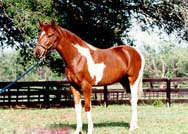Chincoteague Pony
N/A
Mon, 18th November, 2024 - 5:36 am GMT
Sponsor Ads:

Alternative Name
N/ABasic Info
The head is expressive, with broad forehead; large, soft eyes, straight or slightly dished short face; firm muzzle; small, wide-set, tipped-in ears; tapered muzzle, large nostrils and rounded jowls. The body is clean with a, moderately refined throat latch and neck; well-angulated shoulder; broad chest and loins; short back; deep flanks; well-sprung ribs; round croup; straight, sound legs with dense bone and an appearance of overall hardiness; round, hard hooves; adequate mane and tail. The Chincoteague Pony can be found in all common colors, with many pintos among them
Health
Today's horses are actually the size of ponies (average 12- 13 hands) probably due to their poor diet and harsh environment. Some horses removed from Assateague as foals and fed a higher protein diet grow to horse size. Almost 80% of their diet is coarse salt marsh cordgrass and American beach grass. Various grass species, greenbrier stems, bayberry twigs, rose hips, seaweed and poison ivy make up the rest of their diet. The high concentration of salt in their diets causes the horses to drink twice as much fresh water as domestic horses. Because of this, the horses have a "fat" or "bloated" appearance. Although they will sip salt water, they actually drink very little of it.Habitat
N/ABehavior
Because the Chincoteague Pony is a hybrid whose breeding program is largely left to natural selection, conformational traits may vary among individuals. Most ponies tend to resemble the Welsh or Arabian breeds, although Mustang blood is obvious in others.Origin
Island of AssateagueHistory
There are two theories of how the ponies got to the island. The first is that Spanish galleon was bringing Spanish ponies (or horses; different people tell it different ways) to work in mines and such. Because of a storm, the ship was thrown off course. The crashing waves broke the ship as it hit a rocky sand bar. Below the deck, the horses fought to get out of stalls. With the help of nature, they did. They swam towards land, which happened to be Assateague Island. The other story is simple: early colonists let their animals loose on the island to avoid livestock and fenxing taxes. Either way, the ponies are there, and people come from across the country to see them. Chincoteague and Assateague are located off the coast of Virginia and Maryland. People have tried to live there, but in the end moved back to Assateague's sister island, Chincoteague. Assateague is the outer and larger island of the two, and protects Chincoteague from storms from the sea. The ponies are, in turn, very hardy and strong for their size. They range in size from 14 to 15 hands high, though some have been known to be smaller. The ponies are taken care of by the Chincoteague volunteer fire department, and every July these fire fighters get to play cowboy on Pony Penning Day, when the ponies are rounded up and swim across the channel. They are then paraded down the street to the sight of the auction that will be held the next day. There is lots of fun going on, from horse races to wild horse rides, which are like bucking bronco rides at rodeos. Young ponies are auctioned off to keep down the population, because Chincoteague is small and can't support too many ponies.Common Foods
grassSponsor Ads:
The secret of dealing successfully with a child is not to be its parent. --Mell Lazarus
Chincoteague Pony
Coded by: BGID® | ALL RIGHTS RESERVED Copyright © 2000-2024
Disclaimer | Privacy | Report Errors / Contact | Credits

 Homosexual behavior stems from the mind or genetics?
Homosexual behavior stems from the mind or genetics?  The Best Text Adventure You Will Ever Play! The official site:
The Best Text Adventure You Will Ever Play! The official site:  Why haven't we as a collective earth met with aliens yet?
Why haven't we as a collective earth met with aliens yet?  World EcoSystem - Biodiversity Changes - Who is on board and who isn
World EcoSystem - Biodiversity Changes - Who is on board and who isn  Mouthwash - Mouthrinse - Mouth Sores - Healing Infections - Gingivitis
Mouthwash - Mouthrinse - Mouth Sores - Healing Infections - Gingivitis  Treatment for Depression
Treatment for Depression  Ultra radical and violent Islamist group that even rivals Al Qaeda
Ultra radical and violent Islamist group that even rivals Al Qaeda  An idea to have teachers who want to carry guns to school undergo some level of police training will be left up to local school districts and police departments.
An idea to have teachers who want to carry guns to school undergo some level of police training will be left up to local school districts and police departments.